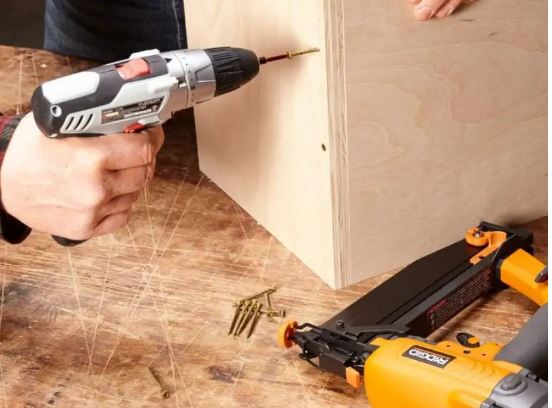Nailing is a crucial aspect of woodworking, construction, and DIY projects. When you’re working with different types of nailers, such as angled nailers, it’s essential to understand the compatibility of nails. “Can You Use Straight Nails in an Angled Nailer?” is a common question among enthusiasts and professionals alike. In this comprehensive guide, we’ll explore the intricacies of this topic, providing you with expert advice, FAQs, and practical tips.
Importance of Using the Right Nails in Nailers
Nails come in various shapes, sizes, and angles, each designed for specific tasks. Choosing the wrong type of nail for your nailer can lead to performance issues, safety concerns, and even project failure. Understanding the importance of nail-nailer compatibility is essential for both beginners and experienced craftsmen.
Can You Use Straight Nails in an Angled Nailer

Before we delve into the specifics, let’s address the central question: Can You Use Straight Nails in an Angled Nailer? The short answer is yes, but with some considerations. Angled nailers are designed for angled nails, typically 20 to 34 degrees. Using straight nails in an angled nailer is possible, but it requires certain adjustments.
Understanding Angled Nailers
To comprehend why straight nails can be used in angled nailers, it’s crucial to understand the design of these tools. Angled nailers are specifically engineered to accommodate nails with an angled collation. This design allows for better access to tight spaces and corner nailing, making them highly versatile for various applications.
Compatibility Issues
While it’s technically possible to load straight nails into an angled nailer, it’s not always recommended. Straight nails lack the collation angle that angled nailers are designed for, which can lead to some compatibility issues. Here are a few things to consider:
- Feeding Mechanism: Angled nailers have a unique feeding mechanism that aligns perfectly with angled nails. Straight nails may not feed as smoothly, leading to jamming or misfires.
- Accuracy: The angle of the nail in an angled nailer is optimized for precision and stability. Using straight nails may compromise the accuracy of your nailing.
- Depth Adjustment: Angled nailers often have depth adjustment settings tailored to angled nails. With straight nails, achieving the desired depth may be more challenging.
Tips for Using Straight Nails in an Angled Nailer
If you find yourself in a situation where you need to use straight nails in an angled nailer, follow these tips to ensure a smoother nailing experience:
Select the Right Size: Choose straight nails that closely match the length and diameter of the angled nails recommended for your nailer.
Check Compatibility: Consult your nailer’s manual to see if it offers any guidance or adjustments for using straight nails.
Test and Adjust: Before starting your project, conduct some test runs to ensure that the straight nails feed correctly and achieve the desired depth.
Be Mindful of Angle: Maintain a steady hand and be mindful of the angle at which you’re holding the nailer. This can help compensate for the lack of an angled collation.
Advantages of Using Straight Nails in an Angled Nailer
Situations Where It May Be Acceptable
- Limited Availability of Angled Nails
- Discuss scenarios where angled nails are not readily available.
- Emergency situations where adapting straight nails is a viable option.
- Project-Specific Considerations
- Highlight projects where straight nails may provide specific advantages.
- Examples of niche carpentry and woodworking tasks.
- Temporary Solutions
- When using straight nails as a temporary workaround is acceptable.
- Emphasize the importance of transitioning to the correct nails when possible.
Benefits of Versatility
- Cost-Efficiency
- Exploring cost savings associated with using one type of nail in various nailers.
- Considerations for budget-conscious DIYers and professionals.
- Reduced Inventory
- Discuss how using straight nails in an angled nailer can simplify nail stock.
- Space-saving advantages for workshops and job sites.
- Adapting to Different Tasks
- Highlight the flexibility of using straight nails for diverse projects.
- How versatility can streamline workflow and improve efficiency.
Tips for Safe Usage
- Nailer Adjustment
- Step-by-step guide on how to adjust an angled nailer for straight nails.
- Precautions to ensure proper alignment and prevent accidents.
- Maintenance
- Maintenance routines for nailers when using non-standard nails.
- Lubrication, cleaning, and inspection considerations.
- Safety Gear
- The importance of using appropriate safety gear when adapting nails.
- Eye and ear protection, dust masks, and gloves.
- Monitoring Performance
- How to monitor the nailer’s performance and nail integrity during use.
- Signs of compatibility issues or potential problems.
- Manufacturer Recommendations
- Checking the manufacturer’s guidelines for using straight nails.
- Following any specific safety instructions provided by the manufacturer.
- Educating the Team
- Training and informing colleagues or team members about safe practices.
- Encouraging a culture of safety when using non-standard nails in nailers.
Frequently Asked Questions
Can I use any type of straight nail in an angled nailer?
Yes, you can use straight nails, but it’s advisable to choose nails that closely match the recommended specifications for your nailer.
Will using straight nails void my nailer’s warranty?
Using straight nails in an angled nailer may void the warranty, as it goes against the manufacturer’s recommendations. Always check your warranty terms before making any modifications.
Are there any safety concerns when using straight nails in an angled nailer?
Safety should be a top priority. Using straight nails may compromise the stability and accuracy of your nailing. Exercise caution and wear appropriate safety gear when using non-standard nails.
Can I switch back to angled nails after using straight nails?
Yes, you can switch back to angled nails after using straight nails, but it’s essential to clean the nailer and ensure it’s free from any remaining straight nails to prevent jamming.
Are there nailer models designed for both straight and angled nails?
Yes, some nailer models are versatile and can accommodate both straight and angled nails. If you frequently switch between nail types, consider investing in one of these models.
Where can I find compatible straight nails for my angled nailer?
You can typically find compatible straight nails at your local hardware store or online retailers specializing in fasteners and construction supplies.
Final Thought
While it is possible to use straight nails in an angled nailer, it’s not the most recommended practice. The design and specifications of angled nailers are optimized for angled nails, and using straight nails may lead to compatibility issues and compromise the quality of your work. If you find yourself in a situation where you must use straight nails, follow our tips for a smoother nailing experience. However, for the best results and to maintain your nailer’s warranty, it’s advisable to use the recommended nails for your specific tool.
Related Topics:
- Why Do Nails Rust
- Is a Nail a Conductor or Insulator
- Why Do Builders Use Nails Instead of Screws
- What Are Construction Nails Made Of
- How Many Nail Pops Are Normal
- Can You Use a Framing Nailer for Siding

